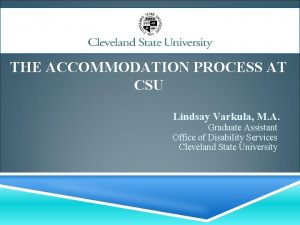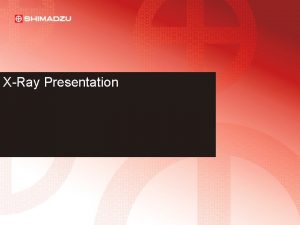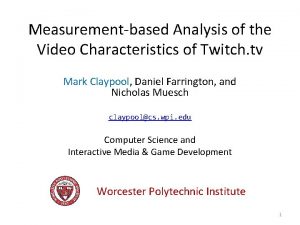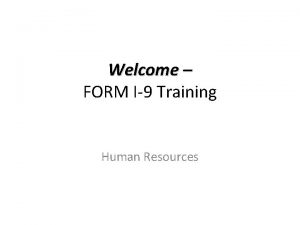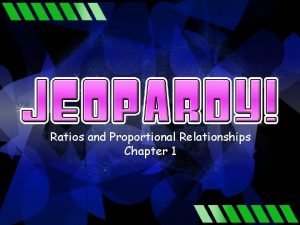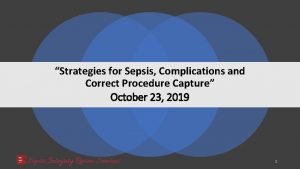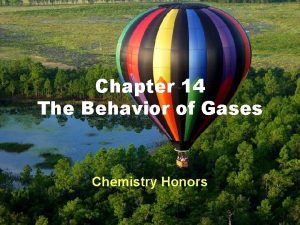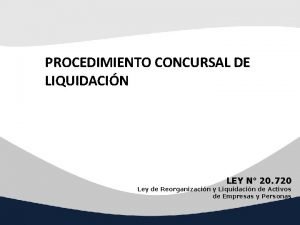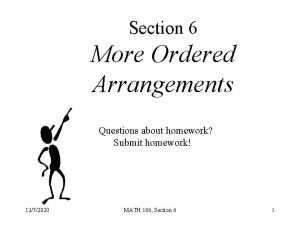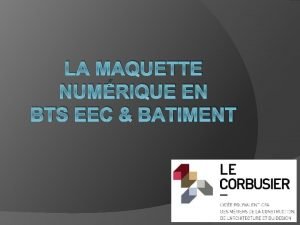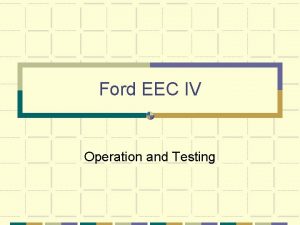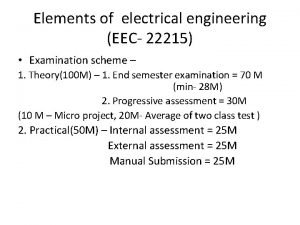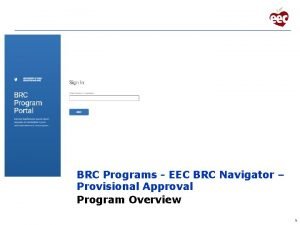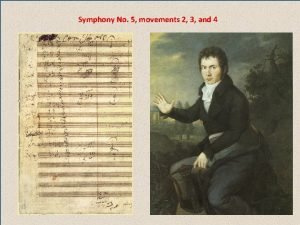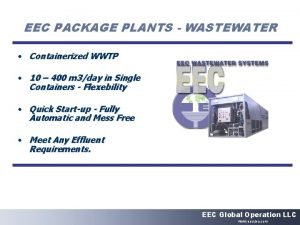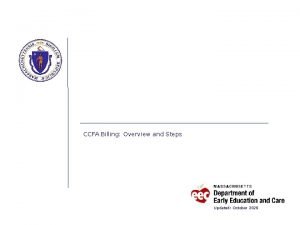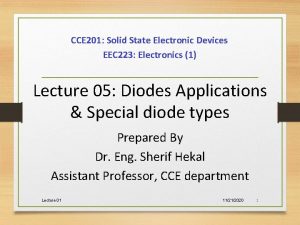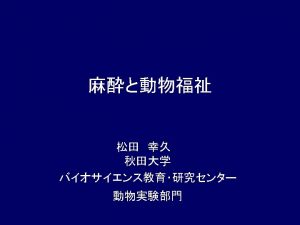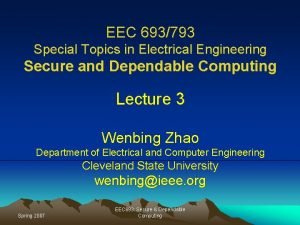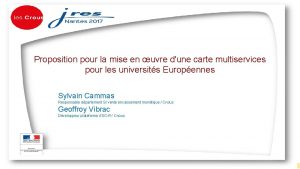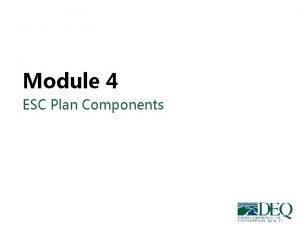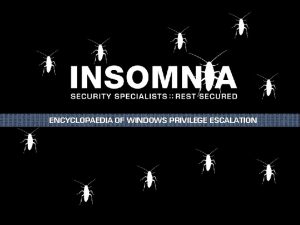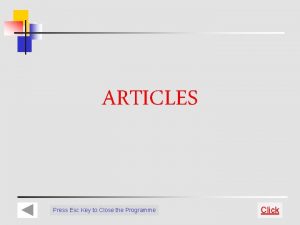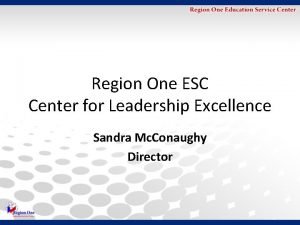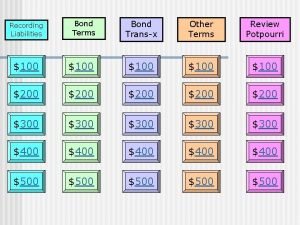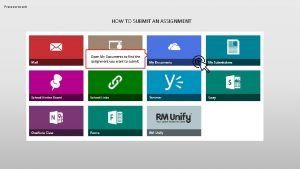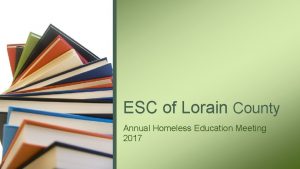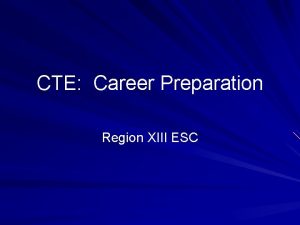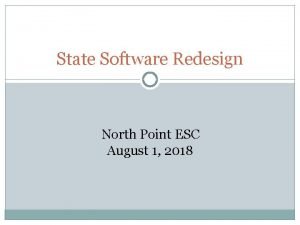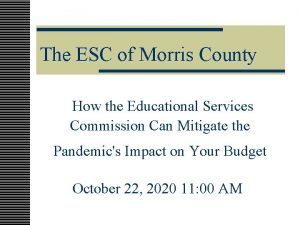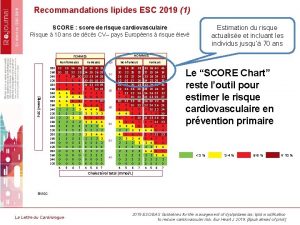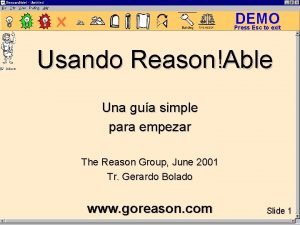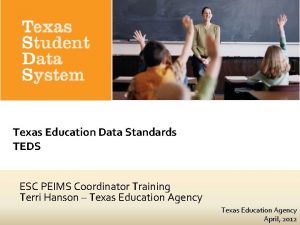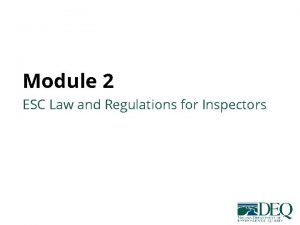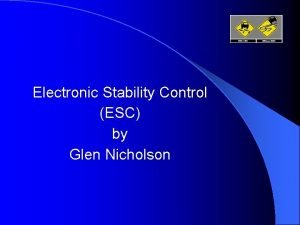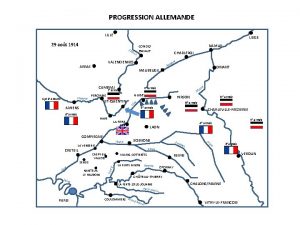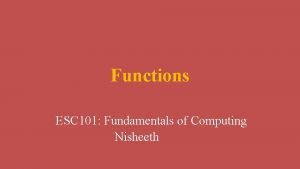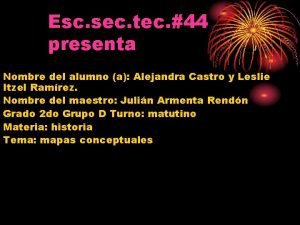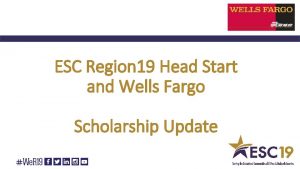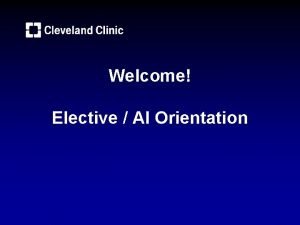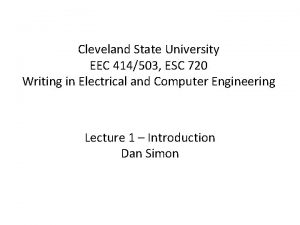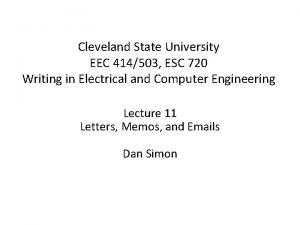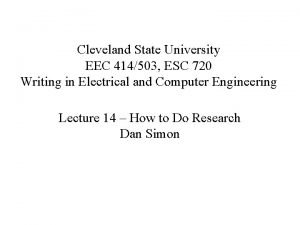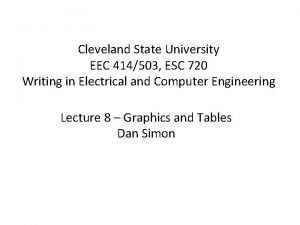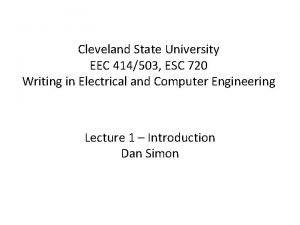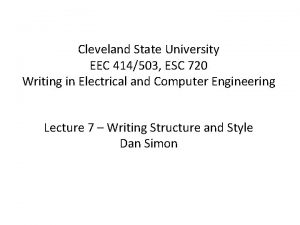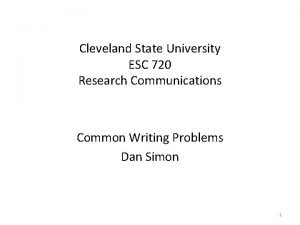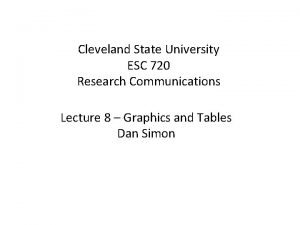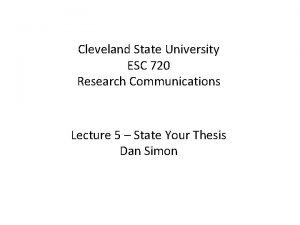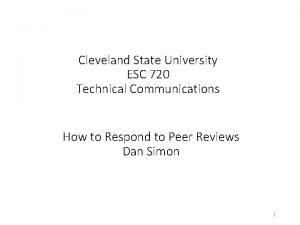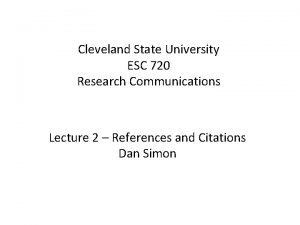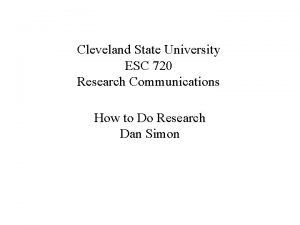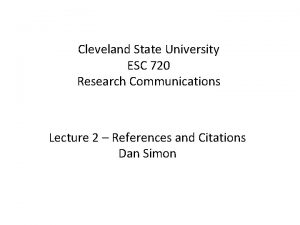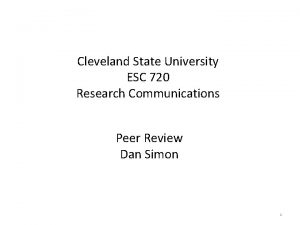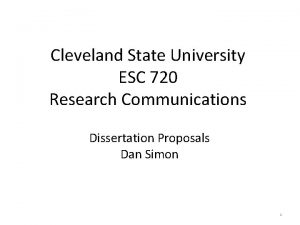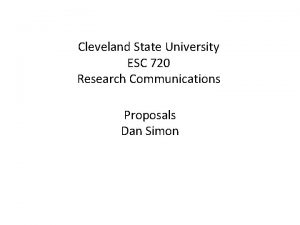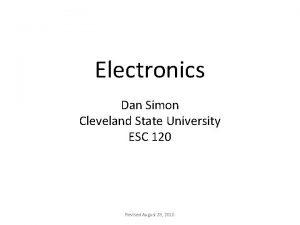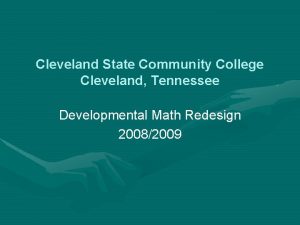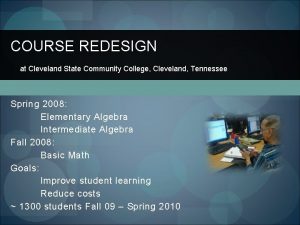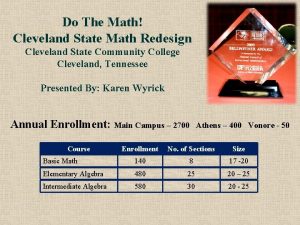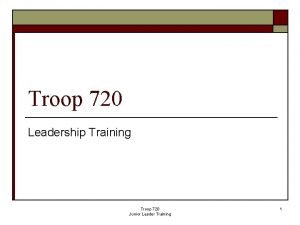Cleveland State University EEC 414503 ESC 720 Writing




















































- Slides: 52

Cleveland State University EEC 414/503, ESC 720 Writing in Electrical and Computer Engineering Lecture 6 – The Writing Process, Effective Writing, and Peer Review Dan Simon

Outline 1. 2. 3. 4. The Writing Process Peer Review Writing Effective Sentences Common Writing Mistakes 2

1. The Writing Process Conduct Research Write paper for iteration = 1 to 100 Proofread Revise If (perfect) then exit loop next iteration 3

1. The Writing Process Plan Draft Revise Proofread 4

1. The Writing Process: Plan a. b. c. d. Research: Gather source material Analyze your audience Analyze your purpose Organize and outline your document – Organization can be based on other similar documents (papers, etc. ) e. Generate a schedule and budget Plan Draft Revise Proofread 5

1. The Writing Process: Plan • Items a, b, and c (Research, Analyze Audience, Analyze Purpose) are not necessarily in order – When writing a thesis, Research is first • Research includes literature review – If you are rewriting a paper for a different audience or purpose, Analyze Audience and Analyze Purpose may be first Plan Draft Revise Proofread 6

1. The Writing Process: Plan a. Research Google Scholar CSU Library: www. ulib. csuohio. edu – Research Databases: IEEE Xplore, INSPEC, … – Subject portals – Virtual Reference Desk Plan – Journal Finder Draft – SCHOLAR Online Catalog Revise – Ohio. LINK Central Catalog Proofread – Interlibrary Loan 7

8

1. The Writing Process: Plan e. Generate a schedule and budget • This may not be required for some writing, but it is for others (conference, proposal, thesis, …) • Graduate thesis schedule: 1. 2. 3. 4. 5. 6. 7. “Final” copy of thesis to advisor Advisor spends two weeks reviewing Student spends two weeks revising Advisor spends two weeks reviewing Final copy of thesis to committee Committee spends two weeks reviewing Student defends thesis two months Plan Draft Revise Proofread 9

1. The Writing Process: Draft Sit down and write – Don’t worry about getting all the details correct – Leave blank spaces and notes to yourself for material (text, proofs, figures, etc. ) to fill in later – This is a very rough draft, for your eyes only. This is NOT the same as the Version A Plan report that you will hand in later for this Draft class! Revise Proofread 10

1. The Writing Process: Revise a. Go over your draft. Fill in the missing material. Correct grammar, spelling, figure placement, formatting, etc. b. Find reviewers. Give them a deadline. – Expert reviewers – Target audience (peer reviews) c. Accept criticism d. Thank your reviewers e. Revise your paper Plan Draft Revise Proofread 11

Outline 1. 2. 3. 4. The Writing Process Peer Review Writing Effective Sentences Common Writing Mistakes 12

2. Peer Review How to conduct a peer review: What is the contribution of the paper? – Is the contribution clearly stated in the abstract, introduction, and conclusion? – Are the claims supported in the paper? – Different types of contributions • • New theory New synthesis New application Tutorial 13

2. Peer Review How to conduct a peer review: – Recommend for or against publication – Different publication venue? – Revision (major, minor)? Resubmission? Is another review needed? – Justify with comments, especially negative reviews • • Constructive criticism General comments Specific comments How confident are you in your review? 14

2. Peer Review How to conduct a peer review: • Should the qualifications (good or bad) of the author be considered? • You need to find a balance between overly permissive and overly restrictive – Consider the standards of the target publication – Students tend to be overly permissive in reviews • Be diplomatic in your criticism 15

2. Peer Review How to conduct a peer review: Ethical Issues – If you submit, then you should review – Do not review a paper if you are not qualified – Watch out for conflict of interest – Prior publication (conference vs. journal) – Simultaneous submission – Plagiarism – Submitted material is for review only unless the author allows its use for other purposes 16

Outline 1. 2. 3. 4. The Writing Process Peer Review Writing Effective Sentences Common Writing Mistakes 17

3. Writing Effective Sentences • Avoid lists in formal writing – a technical paper is not a Power. Point presentation 18

3. Writing Effective Sentences Too long (60 words): Given a system which can fail in one of several different ways, a fault detection and isolation algorithm uses sensor data in order to determine which fault is the most likely to have occurred, the effectiveness of which can be quantified by a confusion matrix, which indicates the probability that each fault is isolated given that each fault has occurred. 19

3. Writing Effective Sentences Too short (14, 17, 10, 17 words): Suppose we have a system which can fail in one of several different ways. A fault detection and isolation (FDI) algorithm uses sensor data to determine which fault is most likely. The algorithm’s effectiveness can be quantified by a confusion matrix. The confusion matrix indicates the probability that each fault is isolated given that each fault has occurred. 20

3. Writing Effective Sentences Just right (28, 25 words): Given a system which can fail in one of several ways, a fault detection and isolation (FDI) algorithm uses sensor data to determine which fault is most likely. The algorithm’s effectiveness can be quantified by a confusion matrix, which indicates the probability that each fault is isolated given that each fault has occurred. 21

3. Writing Effective Sentences • Focus on the real subject – The use of this method eliminates damage. – This method eliminates damage. • Reduce the use of expletives, i. e. , words that do not have a specific meaning – There is no better choice than FPGA technology. – FPGA technology is the best choice. 22

3. Writing Effective Sentences • Write actively – focus on the real verb – The simulations were run 100 times. – We ran 100 simulations. • Use parallel sentence structures – The system costs time and is reducing profits. – The system is costing time and reduces profits. – The system costs time and reduces profits. – The system is costing time and reducing profits. 23

3. Writing Effective Sentences • Parallel sentence structures – I came, I saw, I conquered. – After I arrived in my opponent’s territory, I surveyed the situation, and then undertook a successful military campaign. 24

3. Writing Effective Sentences • What does your modifier modify? – We measured tracking error, control effort, and rise time. Method A only reduced tracking error. – We measured tracking error, control effort, and rise time. Only method A reduced tracking error. – Superstition is a widespread phenomenon in today’s society that should be destroyed. – In today’s society, superstition is a widespread phenomenon that should be destroyed. 25

3. Writing Effective Sentences • The subject of the meeting is artificial intelligence in Compton Lounge. • The subject of the meeting in Compton Lounge is artificial intelligence. • Artificial intelligence is the subject of the Compton Lounge meeting. 26

3. Writing Effective Sentences • Dangling modifiers – Flying happily in the garden, I watched the bee. – I watched the bee flying happily in the garden. – This morning I shot a rhino in my pajamas. – This morning, while in my pajamas, I shot a rhino. – This morning I shot a rhino while I was wearing pajamas. 27

3. Writing Effective Sentences • Dangling modifiers – We used a genetic algorithm with elitism to determine if it could solve the problem better than particle swarm optimization. – We added elitism to determine if it could improve the performance of the genetic algorithm. 28

3. Writing Effective Sentences • Avoid obvious statements – The simulation finished in a nonzero, finite time. • Avoid filler words – The new algorithm is basically simpler. – The new algorithm is essentially simpler. – The end result is a reduction in computer time. – The algorithm is better in each and every way. – The Accelerated Masters program is designed for the best-of-the-best undergraduate students. 29

Outline 1. 2. 3. 4. The Writing Process Peer Review Writing Effective Sentences Common Writing Mistakes 30

4. Common Writing Mistakes • Periods and commas should “always” be followed by a space. • Commas should always be inside a concluding quotation mark. • M. Dische, “Observations on the morphological changes of the developing heart”, Cardiovascular Clinics, vol. 4 (3), p. 175 - 191, 1972 • Exceptions: There are some exceptions, e. g. , when a comma follows an abbreviation. 31

4. Common Writing Mistakes • Hyphens are used to join words – en dashes are used to separate phrases. • Hyphens are shorter than dashes. • Hyphens never have spaces around them. Dashes “always” have spaces around them. 32

4. Common Writing Mistakes Hyphen: En dash: – (MS Word character code 0150) Em dash: — (MS Word character code 0151) Example: Time-invariant systems are easy to understand – or at least they are easier than time-varying systems. • Example: Time-invariant systems are easy to understand—or at least they are easier than time -varying systems. • • 33

4. Common Writing Mistakes Hyphens can be used for clarification • The guard captured five foot soldiers. • The guard captured five foot-soldiers. • The guard captured five-foot soldiers. • I resent your message • I re-sent your message. • I studied the contract and decided to resign. • I studied the contract and decided to re-sign. 34

4. Common Writing Mistakes Hyphens can be used for clarification • Next we study two state systems. • Next we study two-state systems. 35

4. Common Writing Mistakes Articles • The definite article “the” refers to a specific instance. Indefinite articles like “a” and “an” refer to general cases. • Example: We decided to use an FPGA to implement the algorithm. The FPGA that we used was an Altera. 36

4. Common Writing Mistakes • The abstract should be self-contained with no references, usually 100– 200 words, and summarizes the paper; it is often written last • The introduction should contain: – Literature review and background – “Detailed summary” of the contribution of the paper – Overview of the paper • The conclusion should contain: – Summary of the paper – Suggestions for future work 37

4. Common Writing Mistakes Subsections • If you have Section 5. 1, you must also have Section 5. 2 – a section cannot be divided into one subsection. • Section headings should not be the last line on a page of text. 38

This is an example of bad writing because the last line on the page is a section heading. 39

4. Common Writing Mistakes Capitalization • Do not capitalize prepositions, articles, and conjunctions, unless: – Every letter in the phrase is capitalized – The word appears first in a title • • of Mice and Men Of Mice And Men Of Mice and Men OF MICE AND MEN 40

4. Common Writing Mistakes Prepositions • Avoid ending sentences with prepositions – The adaptive H-bridge was the only other topology we compared our method with. – The adaptive H-bridge was the only other topology with which we compared our method. • This is only a general rule. “Ending a sentence with a preposition is a mistake up with which I will not put. ” 41

4. Common Writing Mistakes Parentheses • If a parenthetical phrase is at the end of a sentence, the period belongs outside the parenthesis (like this). • If an entire sentence is parenthetical, the period belongs inside the parentheses. (Here is an example. ) 42

4. Common Writing Mistakes Numbers • Integers should be spelled out if they are less than 10, or if the number begins a sentence. • Integers should be written with numerals if they are greater than nine. • Nineteen of the 20 experiments successfully transformed lead into gold. 43

4. Common Writing Mistakes Numbers • Numbers should usually be written with numerals if they are accompanied by units. • The power supply is five volts. • The power supply is 5 volts. 44

4. Common Writing Mistakes Numbers • 9, 192, 631, 770 Hertz is the frequency of cesium 133. • The frequency of cesium 133 is 9, 192, 631, 770 Hertz. • Thirty-two degrees Fahrenheit is the freezing point of water. • The freezing point of water is 32 degrees Fahrenheit. 45

4. Common Writing Mistakes Capitalization • Capitalize proper nouns (people, places, titles of books and papers and software) • Capitalize personal titles if they precede a person’s name – I had a meeting with Professor Smith. – I had a meeting with Dr. Smith, my professor. – I had a meeting with my professor. 46

4. Common Writing Mistakes Capitalization • Capitalize acronyms, but not their expanded names, unless they should be capitalized according to the rules on the previous page. – We ran a Genetic Algorithm (GA). – We ran a genetic algorithm (GA). – We used an Integrated Circuit (IC). – We used an integrated circuit (IC). 47

4. Common Writing Mistakes • Capitalize words if they are named after a person, depending on general use – We used a Kalman filter – We used a kalman filter – We used a Fourier transform – We used a fourier transform – AC power is 60 hertz – AC power is 60 Hertz – The electronics run on 5 volts – The electronics run on 5 Volts 48

4. Common Writing Mistakes • Math symbols should always be italicized. • A minus sign is not the same as a hyphen. A minus sign is an en dash (close enough). • The letter “x” and the asterisk “*” are not multiplication signs. y = 3 - 2 x sin(z) y = 3 – 2 * sin(z) y = 3 – 2 sin(z) 49

4. Common Writing Mistakes • Define all math terms and symbols the first time they are used. 50

4. Common Writing Mistakes • A number is a word, and a unit is a word. Always separate words with a space. – I had 11 bananas for lunch. – I had 11 bananas for lunch. – We used a 5 V power supply. – We used a 5 V power supply. 51

References • M. Markel, Technical Communication • L. Finkelstein, Pocket Book of Technical Writing • A. Smith, The Task of the Referee, www. cs. wisc. edu/~markhill/the_task_of_the_referee. pdf • D. Simon, Technical Report Template, academic. csuohio. edu/simond/courses/Report. Template. pdf Note: this is not a template for this course – it is a template for general use 52
 Occupational therapy cleveland state
Occupational therapy cleveland state Varkula
Varkula Edx 720 shimadzu
Edx 720 shimadzu 720 pstreams
720 pstreams Proponit 720 ec
Proponit 720 ec Ibm power 595
Ibm power 595 I9 training
I9 training Convert 720 pt/h to qt/min
Convert 720 pt/h to qt/min T8149xa
T8149xa Chapter 14 behavior of gases
Chapter 14 behavior of gases 20/720
20/720 720 h
720 h 40320/720
40320/720 Referentiel bts batiment
Referentiel bts batiment Eec test ford
Eec test ford Eec members
Eec members Eec micro project pdf
Eec micro project pdf Eec brc provisionally approved
Eec brc provisionally approved Beethoven eec
Beethoven eec Eec members
Eec members Https://www.eecusa.com
Https://www.eecusa.com Ccfa eec
Ccfa eec Eec diode
Eec diode Directive 86/609/eec
Directive 86/609/eec Eec engineering meaning
Eec engineering meaning Esc router
Esc router Esc 18
Esc 18 Priv esc windows
Priv esc windows Ecole de commerce la neuveville
Ecole de commerce la neuveville Esc
Esc Region 1 esc
Region 1 esc Transx esc
Transx esc Press esc to exit
Press esc to exit Esc of lorain county
Esc of lorain county Ecole supérieure de commerce la neuveville
Ecole supérieure de commerce la neuveville Region one esc
Region one esc North point esc
North point esc Projet esc
Projet esc Esc of morris county
Esc of morris county Score esc 2019
Score esc 2019 Press esc to exit
Press esc to exit Trumbull county esc
Trumbull county esc Teds esc
Teds esc Esc region 1
Esc region 1 Esc law regulations
Esc law regulations What is esc
What is esc Progression pédagogique esc
Progression pédagogique esc Esc 101
Esc 101 Austraquio
Austraquio Region 19 head start
Region 19 head start Ccf intranet
Ccf intranet Uss cleveland lpd 7
Uss cleveland lpd 7 Kenny chesney cleveland
Kenny chesney cleveland

